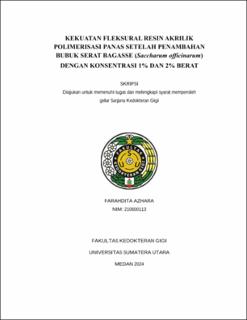| dc.description.abstract | Heat-polymerized acrylic resin (HPAR) is the most commonly used material for denture bases. However, HPAR has a weakness in its mechanical properties, particularly its flexural strength. The flexural strength of HPAR, which is critical when used for chewing, can be improved by adding reinforcement materials such as cellulose from sugarcane fibers (bagasse). In this study, bagasse fibers were treated with alkalization to reduce non-cellulose content. The aim of this study was to determine the effect of adding 1% and 2% bagasse fiber powder on the flexural strength of HPAR. The samples in this study were HPAR specimens measuring 65x10x2 mm. Bagasse fibers were processed into powder using a ball mill, and particle size analysis (PSA) showed an average particle size ranging from 0.010 to 42.30 μm. Bagasse fiber powder was mixed with HPAR at different ratios: powder:polymer for group I (0: 9 g : 4.5 ml), group II (0.09 g: 8.91 g: 4.5 ml), and group III (0.18 g: 8.82 g: 4.5 ml). The dough-stage mixture was molded in a flask and compressed using a hydraulic press. The flask was placed in a water bath for curing, starting at room temperature, then heated to 74°C for 2 hours, followed by 100°C for 1 hour, and finally polished. Flexural strength was measured using a Universal Testing Machine (UTM). The results showed mean flexural strength values of group I (86.331±23.6 MPa), group II (107.386±13.2 MPa), and group III (124.395±43.8 MPa). The data were not normally distributed and were analyzed using the Kruskal-Wallis test, yielding a p-value of 0.019 (p<0.05). Post Hoc LSD test revealed that group III had the most significant difference. It can be concluded that the best flexural strength was achieved in Group III (with the addition of 2% bagasse fiber by weight). | en_US |


